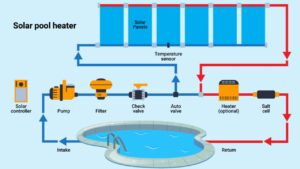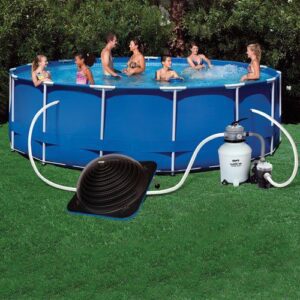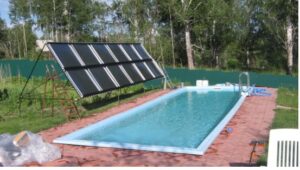Top 10 Advantages of Solar Pool Heating
- Solar pool heating offers several advantages, making it an attractive option for both residential and commercial pools.
- You can refer Working Principle and key Benefits of Solar Energy for heating of Swimming Pool
- Here are some of the key benefits:
1. Cost-Effective Operation
- Low Operating Costs: After the initial installation, the operational costs are minimal since solar energy is free. This can lead to significant savings compared to gas or electric pool heaters.
- Long-Term Savings: While the upfront cost might be higher, the long-term savings on energy bills typically offset the initial investment.

Modern Solar-Pool-Heater
2. Environmentally Friendly
- Renewable Energy Source: Solar heating uses the sun’s energy, a renewable resource, which helps reduce reliance on fossil fuels.
- Low Carbon Footprint: Solar pool heating systems produce no greenhouse gas emissions during operation, contributing to a cleaner environment.
3. Extended Swimming Season
- Increased Pool Usage: Solar heating can extend the swimming season by keeping the pool warm during cooler months or in the evening, providing more opportunities to enjoy the pool.
- Consistent Temperature: Solar systems can maintain a consistent water temperature, enhancing comfort.
4. Low Maintenance
- Durable and Reliable: Solar pool heating systems are generally low-maintenance, with few moving parts and durable materials that can last for many years.
- Simple Operation: Once installed, these systems require little intervention, often functioning automatically with the help of controllers and sensors.
5. Energy Independence
- Reduced Reliance on Utilities: By using solar energy, homeowners can reduce their dependence on grid electricity or gas, subject to price fluctuations and supply issues.
- Off-Grid Capability: Solar pool heating can provide a reliable, independent heating solution in areas where electricity supply is unreliable or costly.
6. Scalability and Flexibility
- Adaptable to Different Sizes: Solar pool heating systems can be scaled to fit pools of various sizes, from small residential pools to large commercial ones.
- Customizable Design: The system can be tailored to specific needs, such as integrating with existing pool equipment or combining with other heating methods for hybrid solutions.
7. Increase in Property Value
- Attractive Feature: A solar-heated pool can be an attractive selling point for potential buyers, adding value to the property.
- Sustainability Appeal: Homes with sustainable features like solar heating are increasingly sought after, appealing to environmentally-conscious buyers.
8. Quiet Operation
- Noise-Free: Unlike gas heaters or heat pumps, solar heating systems operate silently, providing a peaceful pool environment.
9. Support for Energy-Efficient Homes
- Contributes to Overall Efficiency: Integrating solar pool heating with other solar technologies, like PV panels, can contribute to a home’s overall energy efficiency.
- Potential for Tax Credits and Incentives: In some regions, installing solar pool heating systems may qualify for government incentives or tax credits, reducing the initial cost.
10. Low Environmental Impact
- Reduced Water Evaporation: Solar covers, often used with solar heating systems, can reduce water evaporation, conserving water and chemicals used in the pool.
- Less Chemical Use: Warmer water from consistent solar heating can reduce the need for additional chemical treatments, lowering the environmental impact.
These advantages make solar pool heating an appealing choice for those looking to save money, reduce their environmental impact, and enjoy a more comfortable and extended swimming season

Modern Solar Pool Heating Techniques in the USA
- Modern solar pool heating techniques leverage advanced technology to maximize efficiency and sustainability. Here are some of the most current methods:
1. Photovoltaic (PV) Solar Panels with Heat Pumps
- How It Works: PV solar panels generate electricity to power a heat pump, which then heats the pool water. This approach combines the benefits of solar electricity and efficient heat pump technology.
- Usage: Ideal for locations where solar thermal collectors may not be practical or where there’s a desire to use solar power for other applications as well.
- Advantages: Versatile, provides electricity for other uses, and reduces reliance on grid power.
2. Solar Thermal Pool Covers
- How It Works: These covers not only trap heat like traditional solar blankets but also have integrated solar cells that absorb sunlight and directly heat the water.
- Usage: Best for maintaining temperature overnight or during cooler days, serving as both a cover and a heating mechanism.
- Advantages: Multi-functional, easy to use, and reduces evaporation.
3. Floating Solar Rings
- How It Works: These are modular, inflatable rings with a solar-absorbing surface that floats on the pool. They are designed to collect solar energy and transfer it to the pool water.
- Usage: Suitable for those who want a flexible and portable heating solution.
- Advantages: Easy to install and remove, customizable coverage, cost-effective.

Simple solar Power Swimming Pool for Home
4. Solar Pool Heating Mats
- How It Works: These mats are made from durable, UV-resistant material and can be laid out on any flat surface near the pool. Water is pumped through the mats, where it is heated by the sun before being returned to the pool.
- Usage: Ideal for smaller pools or above-ground pools, where space for traditional solar collectors might be limited.
- Advantages: Easy installation, low cost, flexible placement.
5. Integrated Solar Heating in Pool Construction
- How It Works: In this technique, solar heating elements are embedded directly into the pool’s structure, such as in the floor or walls. These elements are connected to a solar heating system that circulates the water through the heated areas.
- Usage: Typically used in new pool constructions or major renovations, where integration is possible.
- Advantages: Seamless integration, aesthetic appeal, and efficient heating.
6. Micro-Channel Solar Collectors
- How It Works: These collectors use a series of small, parallel channels to maximize the surface area exposed to the sun, increasing the efficiency of heat transfer to the water.
- Usage: Suitable for pools of all sizes, offering higher efficiency in a more compact form.
- Advantages: Space-efficient, high heat absorption, durable construction.

Solar Powered Swimming Pool Heater
7. Solar Canopy Systems
- How It Works: A solar canopy is installed over the pool area, providing shade while also capturing solar energy to heat the pool water. The canopy serves dual purposes of shading the pool and heating it simultaneously.
- Usage: Ideal for outdoor pools in sunny climates where shade and heating are both desired.
- Advantages: Dual functionality, protects pool from debris, and reduces chemical evaporation.
8. Advanced Smart Controllers
- How It Works: Modern solar heating systems are equipped with smart controllers that optimize energy use by automatically adjusting water flow, collector angles, and other parameters based on weather conditions and pool usage patterns.
- Usage: Provides hands-free, optimized control over the pool heating process.
- Advantages: Maximizes efficiency, remote monitoring and control, and integrates with home automation systems.
9. Dual-Function Solar Panels
- How It Works: These panels are designed to serve as both solar collectors for heating pool water and as PV panels for generating electricity. This dual-functionality reduces the need for separate systems and maximizes the use of available space.
- Usage: Ideal for areas with limited space for solar installations.
- Advantages: Space-saving, multi-functional, and cost-efficient.
These techniques make modern solar pool heating systems more adaptable, efficient, and environmentally friendly, catering to a wide range of needs and climates.

Selection of best Solar Pool Heater
Capital Cost of a Solar Pool Heater
- The national average cost to install a solar pool heating system is roughly $5,085.
- You need to pay at least $2,000 and up to $7,500 for the first unit
- Labor cost in the USA is $500 to $2,000 for installation.



